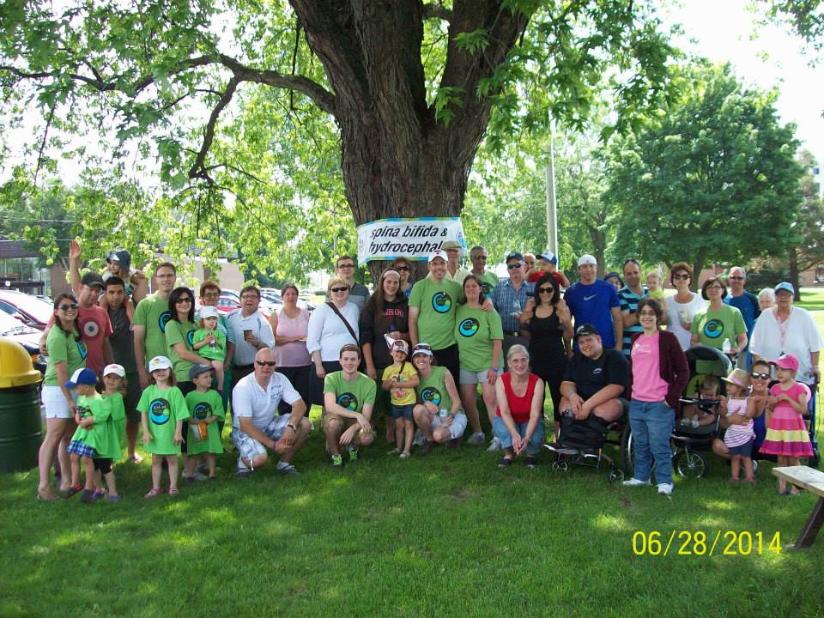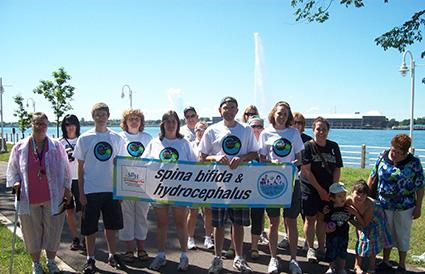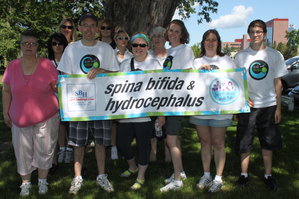
Troy and Annette Chandler on Victoria Day 2013
Credit: supplied
It’s Victoria Day and I’m standing on the front steps of the Chandler home. Annette swings open the door before I can knock and warmly welcomes me in. Her husband Troy is standing behind her smiling, his hands clasped together. This is the first time we’ve all met. Troy has lived with hydrocephalus for his entire life but wasn’t diagnosed with the condition until he was 28 yrs. old. That was almost 20 years ago.
Before we get down to business to talk about ‘Troy’s Trail’ – a local walk organized by the Chandlers to raise money for the Spina Bifida and Hydrocephalus Association of Ontario (SB&H), Troy goes off into the kitchen to make me a tea. Annette and I head to the living room and I feel a bit guilty as I settle into a big overstuffed lazy boy draped with a Bruins throw. I’m pretty sure I’m sitting in Papa Bear’s chair.
As Troy and Annette begin to talk I realize that this is going to be a love story.
*****

Left Build Up of CSF, Righ Normal
Credit: supplied
“Hydrocephalus comes from the Greek word “hydro,” meaning water, and “cephalus,” meaning head. It is a neurological condition that exists when excess cerebrospinal fluid (CSF) builds up in cavities, called ventricles, inside the brain. Fluid accumulates in the ventricles when the body produces more CSF in a day than it can reabsorb. This accumulation causes enlargement of the ventricles, resulting in hydrocephalus.”
The accumulation of CSF could create potentially harmful pressures on the tissues of the brain. In the worst cases, the condition could result in severe brain damage or death. Untreated hydrocephalus has a 50 - 60% death rate, with the survivors having varying degrees of intellectual, physical, and neurological disabilities.

Shunt System
Credit: file
*****
Troy and Annette are high school sweethearts. They began dating in 1984 and married seven years later.
It was March 1994. Troy had finished his shift at work and headed home. He got home around 2:30 a.m.. Annette and their two and a half year old daughter were upstairs sleeping. He fixed himself a rum and coke and plopped down in front of the TV to try to unwind a bit before heading off to bed about half an hour later. And that’s the last thing he remembers about that night.

High School Sweethearts
Credit: family photo
“My head was all ballooned up with fluid. They knew right away. They told us that we had to go to Sudbury to see a neurologist immediately. So we went down to Sudbury thinking that we were going for a consultation. But once we were there the doctor told us that we weren’t going home. I needed to have the surgery right away.”
It was a huge shock for the couple and Annette was terrified for her young husband’s life.
Since the condition is typically congenital Troy is very lucky that he did not have a far more serious outcome from being untreated for twenty-eight years. However, there were a few red flags when as he was growing up.
“When I was younger I was always teased for having a big head. Well I do- but I just thought nothing of it. And then when I was in high school and university I used to get numbness in my arm and my face and I would get so many headaches. The doctor told me it was just stress and to take a couple of Tylenols.”
Troy’s first surgery went well. For five years there weren’t any problems but the years that followed after that were a nightmare. Troy’s shunt malfunctioned nine times. During the worst of these trials Troy underwent surgery four times in one week.
Annette remembers that time very well. Her eyes widen as she tells the story- like she’s reliving it all over again. “His shunt kept blocking and they didn’t know why. I thought I was going to lose him. I really did. I didn’t know what I was going to do. We had two children at the time.”
Thankfully the shunt stopped blocking. Today Troy has gone ten years without complications with his shunt or seizures. Troy’s condition of hydrocephalus can trigger seizures. Though it’s been a decade since his last seizure he continues to take medication daily to ensure that it stays that way. The trade-off is osteoporosis caused by the seizure medication.
Annette has become finely attuned to Troy’s warning signs. She often knows before he does when something is wrong. “Now when it blocks he doesn’t know that it’s happening. He just becomes progressively lethargic and sometimes one of his pupils is dilated.”
There aren’t any neurologists or for that matter neurosurgeons in Sault Ste. Marie. Though these specialists travel to the Sault monthly any consultation for Troy’s condition happens in Sudbury. However, Troy has been fortunate to make a special arrangement with his optometrist.
“There’s an optic nerve behind the eye that swells up if fluid is building up. That’s why his pupil might be dilated. We have an arrangement with his optometrist- it’s covered through OHIP, that he can go in without an appointment. She can look into his eyes and observe the condition of his optic nerve. So when there is a sign that something might be going wrong we can get it checked out right away. We panic all the time. We never know if he’s having a normal headache or if it’s the shunt. This at least puts us at ease.”
As Annette is telling me this Troy is watching her with admiration and smiling. “She actually knows more about this stuff then the doctors you know!”
*****

Early 1990's
Credit: family photo
Troy loses numerous items at a time including the car. But he’s adapted. “I’ve gone into the Station Mall a couple of times now and I walk out the wrong entrance and I can’t find the car. So now I’ve trained myself. Every time I have to go somewhere I know before I get there where I’m going to park. I park in the same spot every time.”
Even throughout our conversation every now and then Troy will look to Annette for confirmation- to make sure he got a date or a location correct. And every now and then Annette will softly correct a detail that Troy might have confused slightly.
After his diagnosis the Chandler’s felt like they were adrift without a paddle. Troy and Annette looked for support groups or foundations that could provide information and guidance but there were no such entities in Sault Ste. Marie.
They took a bad situation and made something good out of it. Annette decided to create Troy’s website . She wrote about Troy’s story and their collective experience living with hydrocephalus. Annette also linked information about the condition to the page. The website was a tool to reach out and to hopefully have someone reach back. And people did.
“It was great. I thought ‘wow, we’re really making a connection here.’ And that’s what we really wanted to do. To find other people like us,” said Annette.
Around the same time the SB&H did a feature story about Troy and posted it on their website. The story received a great response. The Association approached the Chandlers and invited them to be the local contacts for SB&H. They accepted. The Chandlers became the ‘something’ that they had been seeking for so long- the support for people who suffer from hydrocephalus and also for those with spina bifida.
It was Christmas morning when the Chandlers received a phone call. It was a man calling from a hospital bed in Toronto. He had read Troy’s story on the website and wanted to speak to him.
Troy talks about the phone call with a lot of passion. “This guy was flown in from New Brunswick to Toronto. He was just diagnosed with hydrocephalus and was waiting for his surgery. He was completely alone. We talked for a long time. I get goose bumps thinking about it because I was able to be there for someone. I was able to help somebody.”
*****
June is Spina Bifida and Hydrocephalus Awareness month. The Chandlers are organizing the second annual ‘Troy’s Trail: Spirit Wheel Walk Run. On June 8th families, friends, strangers and those living with spina bifida and hydrocephalus will gather at Clergue Park at 11 a.m.. The route is a manageable length. Participants will walk along the boardwalk and back. Money raised for the event goes directly to SB&H.

Wedding 1991
Credit: family photo
“The walk was started to create awareness about this condition. And if we could reach a couple of new people every year that live with this that would be great. We want people to know that we’re here, that we’re a support system. They can send us an email, pick up the phone or we can get together for coffee,” Troy pauses a moment. “We don’t want anyone to feel like they have to go through this alone like we did. Were still living this life right now but we’ve been through everything. Now we want to pay if forward.”
After meeting the Chandler’s I’m convinced that this couple could teach people about a lot more than living with hydrocephalus. The still young couple have loved each other for thirty years through the ups and downs of the condition; the uncertainty of what’s around the corner; the financial hardship that families experience when dealing with perpetual health issues; and then the everyday challenges of raising a family and holding down jobs.
At the end of the day Troy and Annette are like every other married couple. They settle in for the night, enjoy a glass of wine or two and watch Survivor. Of course the PVR is taping the episode as they’re watching it. Sometimes Troy wakes up the next morning and can’t remember who was voted off the island. He gets to watch it twice!
Troy and Annette haven’t just stuck out for better or worse, for richer or poorer and in sickeness and health- they’ve kicked it in the butt. But more so, they have figured out the happily ever after bit too.
*****
If you would like to make a donation to or participate in Troy’s Trail: Spirit Wheel Walk Run on June 8th please call 705.946.4532 or 1.800.387.1575.







